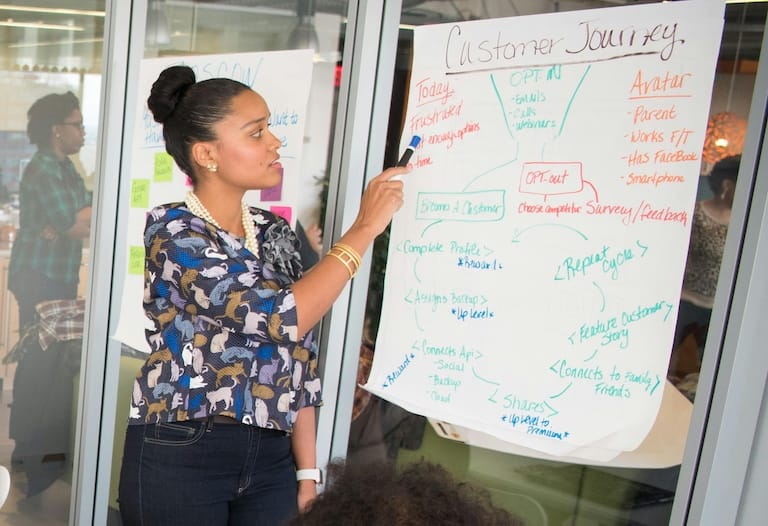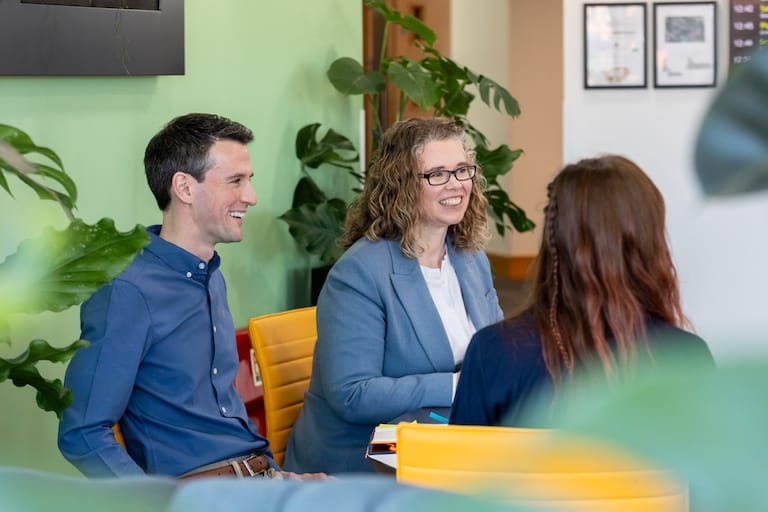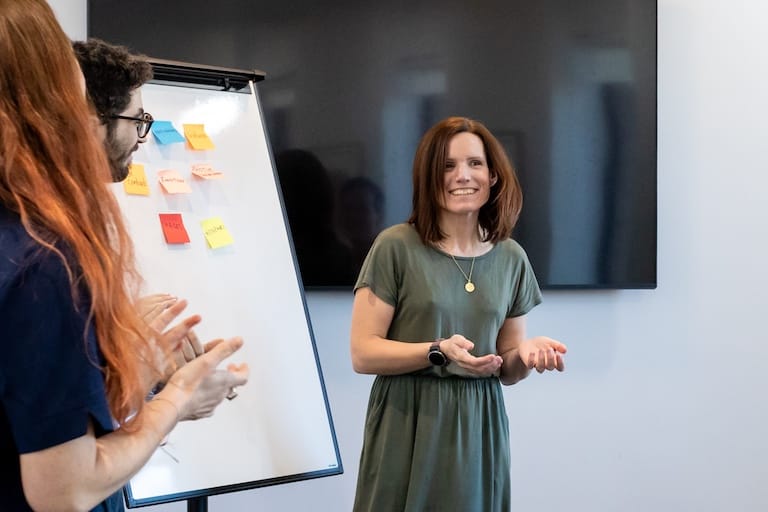
A Manager’s Guide to Getting Difficult Conversations Right
June 23, 2025
How to Know If Communication Skills Training Will Work for Your Team
August 11, 2025FURTHER EXPERTISE
Seven easy ways to make your meetings more effective
Expert Opinion from Rich Watts published July 4, 2025
Love them or loathe them, meetings are a key part of working life. When they work well, meetings are where we share ideas, make decisions, solve problems and align around what happens next. When meetings work badly, they lack focus, drag on without clear outcomes and leave you wondering why you were even there.
This blog post is focused on the top tips, ideas and insight that you need to make your meetings more effective. Focused, action-orientated, inclusive and they kind of meetings that your team mates look forward to attending!
First, let’s quickly define what we mean by a meeting, and what makes one effective.

BUT FIRST...
What is a meeting?
A meeting is any planned conversation between two or more people that has a purpose. It might be a formal team meeting, a one-to-one, a workshop, or a quick check-in. The format matters less than the intention behind it. Meetings can be work-related, or might take place within your personal life, perhaps as part of a voluntary organisation.
What is an effective meeting?
An effective meeting achieves what it set out to do, involves the right people in the right way, and leads to useful action afterwards. It feels like a good use of everyone’s time. People leave clear on what was discussed, what was decided, and what happens next.
So how can we make our meetings more effective?
Here are seven key ideas to make your meetings everything that they need to be.
The format matters less than the intention behind it. Meetings can be work-related, or might take place within your personal life, perhaps as part of a voluntary organisation.
Discover how our training goes Further
SET SOME INTENT
1. Be clear on the purpose
Every meeting should have a clear reason for happening. The purpose is the guiding idea that keeps everyone focused and ensures the meeting adds value.
Without a clear purpose, meetings can drift. People may not know why they are there, and discussions can become vague or circular. A shared sense of purpose helps people prepare, contribute and stay engaged. Purpose therefore drives productive conversations and outcomes. It stops meetings dragging on for longer than is needed too!
How to be clear on the purpose of your meeting
When setting up the meeting, write a one-line purpose in the invite. It could be a goal, or a focus for the discussion. If it is a goal, try and make it SMART (Specific, Measurable, Achievable, Realistic and Time-specific). For example: ‘To agree next quarter’s priorities’ or ‘To solve a resourcing challenge for Project X.’ Begin the meeting by stating the purpose out loud. If the conversation wanders, remind everyone of the meeting purpose to bring things back on track.
If you set a great purpose, then you will find that an agenda and timings for the meeting will quickly become clear.
If something arises that is important, but doesn’t fall within the purpose of the meeting, then move it to the car park (check out point 6 in this article!)
ENCOURAGE ENGAGEMENT
2. Make space for everyone to contribute
Effective meetings include all voices, not just the most confident people or the most senior. Creating deliberate moments for input helps ensure the group benefits from the full range of people and personalities within the meeting room.
Some of us often have useful ideas but do not always feel confident or invited to share them. Some of us prefer more time and space to reflect and contribute. When everyone contributes, the group makes better decisions and individuals feel more involved. The best ideas often come from the quietest point in the room.
How to encourage everyone to contribute to a meeting
Use simple structures like rounds. A round is when you go around the group and invite each person to take a turn to share their thoughts on a question. Keep it short and informal. For example, ‘Let’s each share one idea for how we could approach this.’
You can also invite people to jot down ideas in silence before opening discussion. Or pair people up to talk for a few minutes before feeding back to the group. These approaches help create a more balanced and inclusive meeting and avoids everyone being influenced by the ideas that they have already heard if you are doing a ‘round’’.

MAKING IT HAPPEN...
3. Record clear next steps and actions
An effective meeting ends with clear agreement on what happens next. Make sure that everyone knows who is doing what, by when, and how it will be followed up.
The greatest meetings and conversations will be wasted if nothing changes afterwards. Clarity on actions helps maintain momentum and ensures shared accountability.
How to record clear next steps and actions in a meeting
Towards the end of the meeting, pause and ask: ‘What are the next steps?’ Name actions clearly, assign ownership and agree deadlines. Capture these in a visible way such as a shared document or notes on a screen so that everyone sees and agrees them before leaving the meeting room. After the meeting, share a short summary with everyone including actions and deadlines. Diarise follow-ups that remind you to check-in on progress.
If you are meeting online, lots of online meeting tools now include the option to record, transcribe and even create meeting notes using AI. Explore the possibility of using ai to efficiently record next steps and actions from your meetings.

FOCUS
4. Give your full attention
Effective meetings ask for focus. That means people are present and engaged, not distracted by emails, phones or other tasks. This is increasingly difficult to achieve in today’s digital world where team members believe that they need to be ‘always on’ and connected to their laptops or phones.
When attention is divided, communication suffers. People miss things, repeat themselves or fail to follow the flow. It also signals to others that the meeting is not important. Lack of attention from members of a meeting makes the meeting less effective for everyone.
How to encourage full attention within a meeting
Set an expectation at the start: invite people to close laptops and put phones away. You might say, ‘Let’s all give this our full attention.’ If someone needs to stay reachable for something urgent, agree that they can step out if needed. Modelling this yourself will also set the tone for the group. Don’t be afraid to politely call out members of the meeting that break these expectations. Your colleagues will thank you for your dedication to effective meetings.
EXPERTS IN THE ROOM
5. Invite the right people
An effective meeting involves the people who are essential to achieving the purpose. Great meetings avoid inviting people who do not need to be there.
Too many people can make meetings slow and unfocused. Too few can lead to missing information or decisions being delayed. Having the right mix ensures the meeting can achieve its aims.
How to ensure that meetings include the right people
Before inviting people, ask: ‘Who needs to be there to help us meet this purpose?’ Unless your meeting is a deep-dive into a specific topic or specialist area, avoid doubling up on similar roles or expertise. If someone does not need to attend the full meeting, offer to share notes or follow up with them directly. Being thoughtful about who attends shows respect for people’s time and will boost the quality of your meeting.

STAY ON-TOPIC
6. Use the ‘car park’
The car park is a space (either physical or digital) where you park useful but off-topic ideas for future discussion.
In most meetings, interesting topics come up that are not relevant to the purpose. If you explore them all, the meeting loses focus. If you ignore them completely, you may miss important insights. The car park helps strike a balance.
How to use the ‘car park’ in meetings
Introduce the concept of the car park at the start of your meeting. This helps to set expectations and reinforce the purpose and focus of your meeting.
Create a visible list where you capture off-topic items as they arise. You can say, ‘That’s a great point – let’s park it so we can come back to it at the right time.’ Review the list briefly at the end to decide what needs following up. This helps keep meetings on track without shutting down valuable thinking.

REVIEW AND REFINE
7. Always reflect on how the meeting went
Before the meeting ends, take a moment to reflect as a group on how it went. Ask what worked, and what could be better next time.
This type of regular, brief reflection helps build a culture of continuous improvement. It shows that meetings are not just a routine but something you are actively working to make better.
Questions to ask for more effective meetings
You can ask, ‘Out of ten, how effective was this meeting?’ or ‘What is one thing we did well, and one thing we could improve?’ Keep it light, honest and blame-free. Over time, these small reflections lead to stronger habits and better results.

IN CONCLUSION
Always remember
Meetings are a reflection of your team’s culture. When they are focused, inclusive and action-driven, they build trust and momentum. Try applying even one or two of these ideas in your next meeting and keep building from there. Small changes will make a big difference.
Better meetings do not just save time. They help people think better, act faster and work more effectively together.
Check out our effective meetings training course here for more ideas on how to make your meetings more effective




